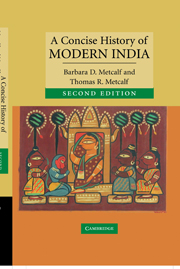Book contents
- Frontmatter
- Contents
- List of illustrations
- Preface to the second edition
- Preface to the first edition
- Glossary
- Chronology
- 1 Sultans, Mughals, and pre-colonial Indian society
- 2 Mughal twilight: the emergence of regional states and the East India Company
- 3 The East India Company Raj, 1772–1850
- 4 Revolt, the modern state, and colonized subjects, 1848–1885
- 5 Civil society, colonial constraints, 1885–1919
- 6 The crisis of the colonial order, 1919–1939
- 7 The 1940s: triumph and tragedy
- 8 Congress Raj: democracy and development, 1950–1989
- 9 Democratic India in the nineties: coalitions, class, community, consumers, and conflict
- Epilogue: a new century begins
- Biographical notes
- Bibliographic essay
- Index
- CAMBRIDGE CONCISE HISTORIES
1 - Sultans, Mughals, and pre-colonial Indian society
Published online by Cambridge University Press: 05 June 2012
- Frontmatter
- Contents
- List of illustrations
- Preface to the second edition
- Preface to the first edition
- Glossary
- Chronology
- 1 Sultans, Mughals, and pre-colonial Indian society
- 2 Mughal twilight: the emergence of regional states and the East India Company
- 3 The East India Company Raj, 1772–1850
- 4 Revolt, the modern state, and colonized subjects, 1848–1885
- 5 Civil society, colonial constraints, 1885–1919
- 6 The crisis of the colonial order, 1919–1939
- 7 The 1940s: triumph and tragedy
- 8 Congress Raj: democracy and development, 1950–1989
- 9 Democratic India in the nineties: coalitions, class, community, consumers, and conflict
- Epilogue: a new century begins
- Biographical notes
- Bibliographic essay
- Index
- CAMBRIDGE CONCISE HISTORIES
Summary
Imagine a time traveller standing in Mughal Delhi, amidst the splendor of the emperor Shah Jahan's (r. 1627–58) elegant, riverside city, in the year 1707 (plate 1.1). News had come of the death of Shah Jahan's long-ruling son, Aurangzeb (r. 1658–1707) in the distant Deccan, where he had been engaged in arduously extending his vast empire. The traveller, understandably wondering what the death of a mighty monarch would mean, might first have looked back in time a century, say to the death of Shah, Jahan's grandfather, Akbar (r. 1556–1605). Had he done so, he would have seen the key institutions in place that had made the Mughals, in the intervening century, the most powerful empire the subcontinent had ever known. It was far greater in population, wealth, and power than the contemporaneous Turko-Mongol empires with which the Mughals shared so much: the Persian Safavids and the Ottoman Turks. The Mughal population in 1700 may have been 100 million, five times that of the Ottomans, almost twenty that of the Safavids. Given the trajectory of continuity and growth that had taken place in the seventeenth century, our time traveller at the turn of the eighteenth century might legitimately have imagined a Mughal future to match the glorious past.
But if, Janus-faced, the traveller then looked ahead a century, say to 1803, he would have found not continuity but extraordinary change.
- Type
- Chapter
- Information
- A Concise History of Modern India , pp. 1 - 28Publisher: Cambridge University PressPrint publication year: 2006

